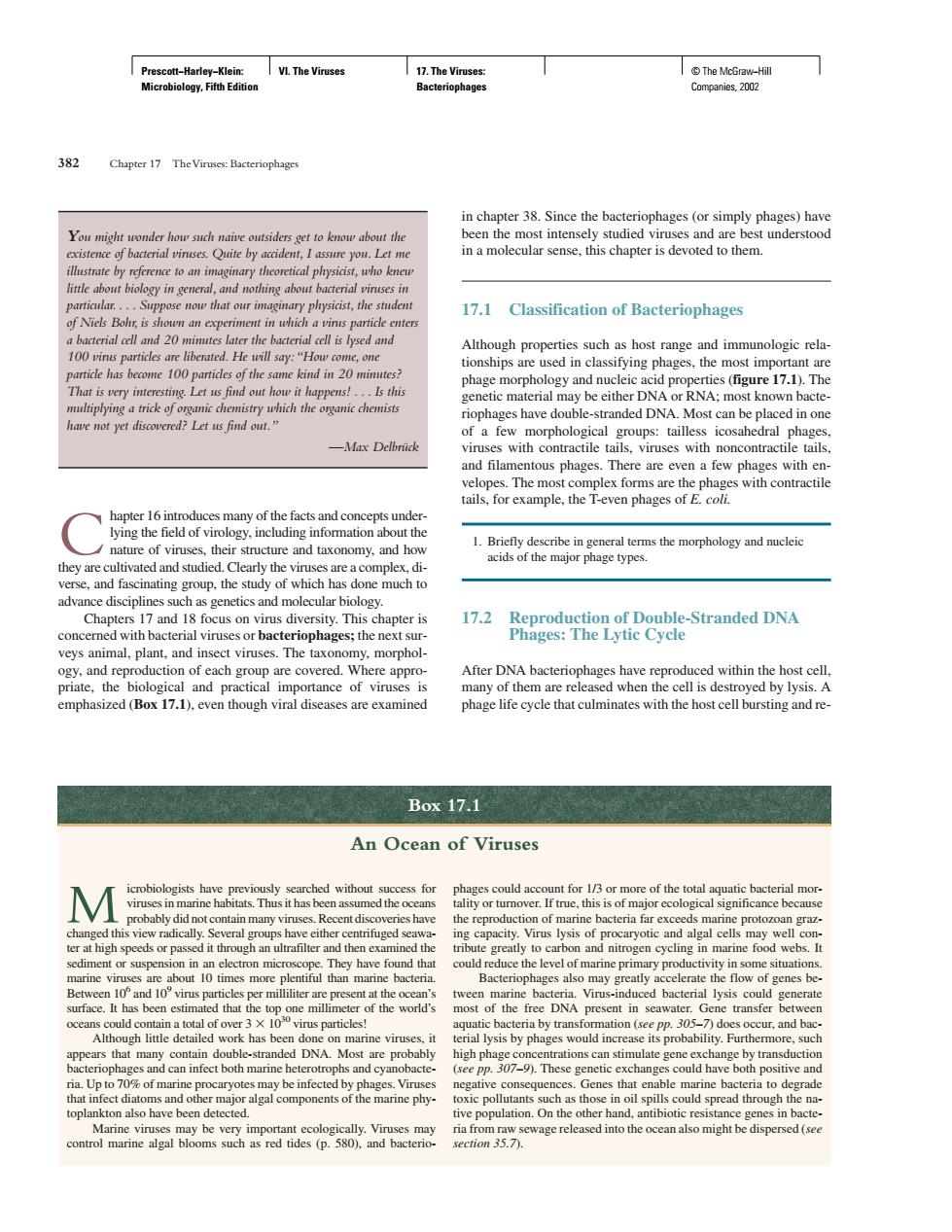正在加载图片...

82 Chapter 17 The Viruses:Bacteriophoge ina molecular sense.this chapter is devoted to them. nce to an ical phy 17.1 Classification of Bacteriophages nages,the m have not yet discovered?Let us find out. nophage have d in on -Max Delbnick ails,for the Teven phages of ity This pter i 17.2 with bacterial viruses or bacteriophages;the nex oy,and re duction of eachg .Where Box 17.1 An Ocean of Viruses the repr They have found the level of and tween Virs-induced b ocean by tr n (s and ba high pha9).Thes ionscantieeceidcohpoic oxic p spill ould spr c0m35.7 d into the ocean aPrescott−Harley−Klein: Microbiology, Fifth Edition VI. The Viruses 17. The Viruses: Bacteriophages © The McGraw−Hill Companies, 2002 382 Chapter 17 The Viruses: Bacteriophages You might wonder how such naive outsiders get to know about the existence of bacterial viruses. Quite by accident, I assure you. Let me illustrate by reference to an imaginary theoretical physicist, who knew little about biology in general, and nothing about bacterial viruses in particular.... Suppose now that our imaginary physicist, the student of Niels Bohr, is shown an experiment in which a virus particle enters a bacterial cell and 20 minutes later the bacterial cell is lysed and 100 virus particles are liberated. He will say:“How come, one particle has become 100 particles of the same kind in 20 minutes? That is very interesting. Let us find out how it happens! . . . Is this multiplying a trick of organic chemistry which the organic chemists have not yet discovered? Let us find out.” —Max Delbrück Chapter 16 introduces many of the facts and concepts underlying the field of virology, including information about the nature of viruses, their structure and taxonomy, and how they are cultivated and studied. Clearly the viruses are a complex, diverse, and fascinating group, the study of which has done much to advance disciplines such as genetics and molecular biology. Chapters 17 and 18 focus on virus diversity. This chapter is concerned with bacterial viruses or bacteriophages; the next surveys animal, plant, and insect viruses. The taxonomy, morphology, and reproduction of each group are covered. Where appropriate, the biological and practical importance of viruses is emphasized (Box 17.1), even though viral diseases are examined in chapter 38. Since the bacteriophages (or simply phages) have been the most intensely studied viruses and are best understood in a molecular sense, this chapter is devoted to them. 17.1 Classification of Bacteriophages Although properties such as host range and immunologic relationships are used in classifying phages, the most important are phage morphology and nucleic acid properties (figure 17.1). The genetic material may be either DNA or RNA; most known bacteriophages have double-stranded DNA. Most can be placed in one of a few morphological groups: tailless icosahedral phages, viruses with contractile tails, viruses with noncontractile tails, and filamentous phages. There are even a few phages with envelopes. The most complex forms are the phages with contractile tails, for example, the T-even phages of E. coli. 1. Briefly describe in general terms the morphology and nucleic acids of the major phage types. 17.2 Reproduction of Double-Stranded DNA Phages: The Lytic Cycle After DNA bacteriophages have reproduced within the host cell, many of them are released when the cell is destroyed by lysis. A phage life cycle that culminates with the host cell bursting and reMicrobiologists have previously searched without success for viruses in marine habitats. Thus it has been assumed the oceans probably did not contain many viruses. Recent discoveries have changed this view radically. Several groups have either centrifuged seawater at high speeds or passed it through an ultrafilter and then examined the sediment or suspension in an electron microscope. They have found that marine viruses are about 10 times more plentiful than marine bacteria. Between 106 and 109 virus particles per milliliter are present at the ocean’s surface. It has been estimated that the top one millimeter of the world’s oceans could contain a total of over 3 1030 virus particles! Although little detailed work has been done on marine viruses, it appears that many contain double-stranded DNA. Most are probably bacteriophages and can infect both marine heterotrophs and cyanobacteria. Up to 70% of marine procaryotes may be infected by phages. Viruses that infect diatoms and other major algal components of the marine phytoplankton also have been detected. Marine viruses may be very important ecologically. Viruses may control marine algal blooms such as red tides (p. 580), and bacterioBox 17.1 An Ocean of Viruses phages could account for 1/3 or more of the total aquatic bacterial mortality or turnover. If true, this is of major ecological significance because the reproduction of marine bacteria far exceeds marine protozoan grazing capacity. Virus lysis of procaryotic and algal cells may well contribute greatly to carbon and nitrogen cycling in marine food webs. It could reduce the level of marine primary productivity in some situations. Bacteriophages also may greatly accelerate the flow of genes between marine bacteria. Virus-induced bacterial lysis could generate most of the free DNA present in seawater. Gene transfer between aquatic bacteria by transformation (see pp. 305–7) does occur, and bacterial lysis by phages would increase its probability. Furthermore, such high phage concentrations can stimulate gene exchange by transduction (see pp. 307–9). These genetic exchanges could have both positive and negative consequences. Genes that enable marine bacteria to degrade toxic pollutants such as those in oil spills could spread through the native population. On the other hand, antibiotic resistance genes in bacteria from raw sewage released into the ocean also might be dispersed (see section 35.7)